Using social media platforms can be expensive—and that’s only when advertising is involved. Often, it can be difficult to quantify the total costs of social media platforms.
The true cost of using social media marketing platforms will always depend on several factors unique to the brand using them. But aside from deciding on the final number of your marketing budget, it’s important to understand (and therefore allot funding properly) what exactly is involved in managing your social media presence using social media marketing tools. Here’s a breakdown of how to understand why your budget for social media marketing platforms costs as much as it does—and the significance of these costs to your brand’s growth online.
Breaking Down the Costs of Using Social Media Marketing Platforms:
An Overview of What’s Needed to Thrive on a Social Media Platform
The best way to understand the costs of social media marketing platforms is to break down the essentials of what it takes to establish and maintain a brand online—in short, where all your money is going. In the US specifically, in 2023, marketing respondents allocated around 17% of their marketing budget to social media marketing. In 2024, this number is expected to rise to 20.3%.
There are three components necessary to establish and maintain a social media presence:
- Management tools and software: third party tools which can help your manage, automate, and create your social media content/activities
- Advertising costs on platforms: the costs of running an ad campaign on a social media platform
- Social media teams/staff: the personnel in charge of managing your social media platforms
While these seem simple at the outset, many brands are often caught off-guard by the true cost of social media marketing because they have a limited understanding of what exactly these three components entail. When this happens, they’re less likely to have enough funds and resources to launch a social media marketing campaign effectively. And in worst-case scenarios, they’re far more likely to misallocate budgets or attempt to save costs without fully understanding how cuts will affect their overall budget.
How can you avoid this? By breaking down these components into their key parts, you’ll be able to decide which ones work best for your social media strategy overall.
Social Media Management Costs
Social media management has gone beyond simply creating and maintaining a profile for your brand on any social media platform. Because of the sheer amount of user touchpoints, impressions, channels, algorithm changes, and content types, there’s too much data to keep track of manually. This becomes troublesome once you start trying to gauge how effective your marketing efforts are.
Because of this, social media management tools and project management tools have become an essential part of any brand’s social media strategy — and a key consideration for costs.
Social Media Management Tools
Examples: Hootsuite, Sprout Social, Loomly, Brandwatch, and HubSpot
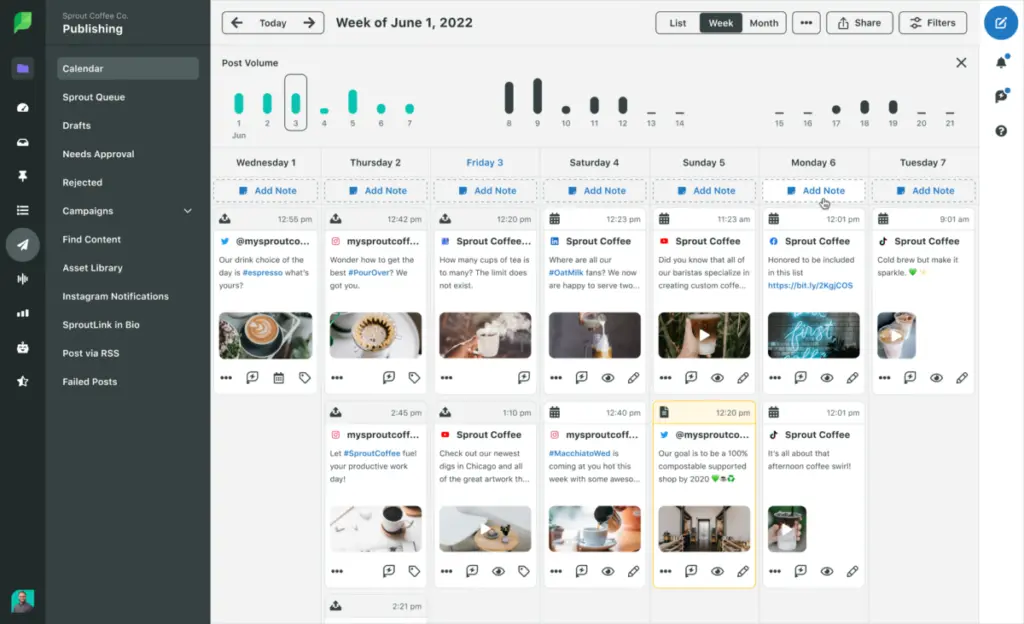
Source: sproutsocial.com
Average Cost: $100 to $2,000+ per month
Many social media management tools prioritize useability over features, which means many of the costs associated with their use increase in proportion to the features or support provided. For many providers, you’ll be able to get the minimum features necessary to manage your social media marketing across platforms. Meanwhile, premium features unlock ways to automate tasks, make collaboration easier, or give you access to customer support.
What You Get for the Cost
Social media management tools can help you become more efficient in how you manage your social media platforms and help your team focus on aspects that need more attention.
Premium versions (or plans) offered by these tools can be an excellent investment for brands as they ramp up their social media marketing. Since growth on social media is often exponential, brands benefit from having the capability to scale up (or down).
Many providers do offer bespoke or customized plans depending on an agency’s size or needs. In situations where pre-packaged plans may not be enough, you can always contact the platform or tool developer to negotiate better costs for your brand. Nokia, for instance, leveraged Hootsuite’s Enterprise plan (custom pricing) to gain more social media impressions, increase their followers, and gain top ranking in terms of share of voice at a large mobile tech event.
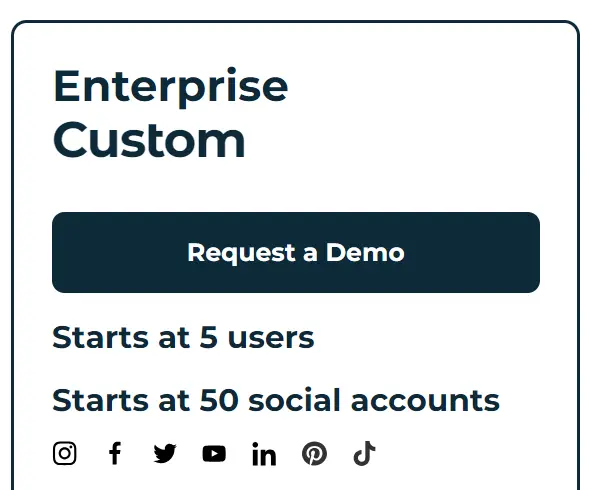
Source: hootsuite.com
Mobile World Congress: @nokia and @GSMA take the title of the most talked about brands: https://t.co/LBDVtAQh7P pic.twitter.com/dHqA1uY0uS
— Brandwatch (@Brandwatch) March 6, 2017
Let’s look at the summary of costs associated with popular social media management tools:
Hootsuite Sprout Social Loomly Brandwatch HubSpot Monthly price range $99 to $249 $249 to $499 per seat/month $42 to $369 Undisclosed $15/month/seat to $3,600 per month Free trial ✅ ✅ ✅ ❌ ❌ Free plan ❌ ❌ ❌ ❌ ✅ Custom pricing ✅ ✅ ❌ ✅ ✅
Social Media Project Management Tools
Examples: Basecamp, Asana, HubSpot, TeamWork Projects, and Trello
Project management tools offer a convenient way for your social media marketing team to keep track of your campaigns, content assets, and internal communication in a single place. Let’s explore the costs associated with these tools below.
Average Cost: $10 to $50 per user
In general, social media project management tools are priced based on two models:
- Per user: Plans are priced per registered user in your organization
- Tiered pricing: Plans are priced depending on features offered, including number of users
In both models, prices increase depending on how many features you want (or how many more users are added to the plan), giving you flexibility in choosing what tier of pricing works for your organization best.
In most cases, smaller organizations will get more mileage out of social media project management tools that charge per user, as this can help them budget easily against their needs. Tiered pricing is generally more suitable for bigger organizations, as the number of people they staff usually fall under the set number of users per tiered plan.
Meanwhile, there are also platforms that allow for unlimited users. Spotify, for example, utilized Asana’s Enterprise plan, which doesn’t have user seat limits. This allowed the company’s employees to collaborate with agencies and scale up without facing the hassle of limited users.
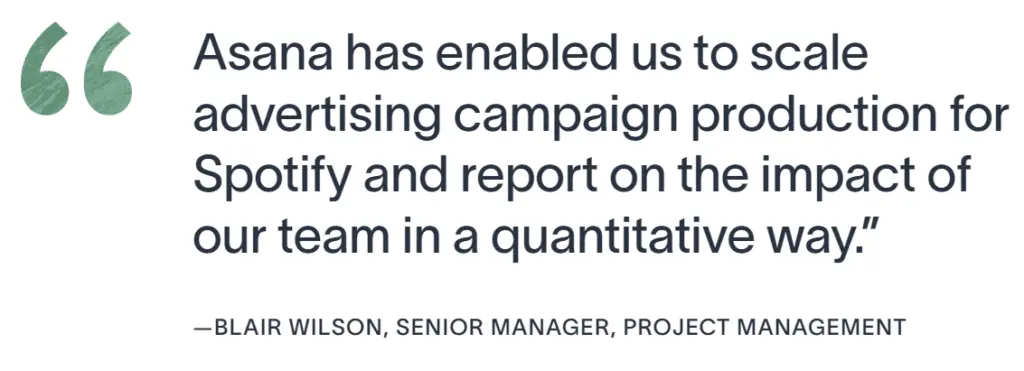
Source: asana.com
What You Get for the Cost
As a central hub for all of your brand's content, project management software can help improve collaboration across teams, shorten turnaround times, and overall make your marketing team work more efficiently—a return well worth their initial costs.
Another benefit is the flexibility afforded by the pricing plans of project management tools help them become more cost-effective for your brand long-term. Organizations can scale their needs depending on how many people use the tool. They can add more features as their organization or social media marketing campaigns grow in size and scope. The flexibility of project management tools makes them worth their cost for any organization regardless of size for short and long-term projects alike.
Here’s a summary of the costs you can expect from leveraging popular social media project management platforms:
Basecamp Asana Teamwork Projects Trello Monthly price range $99 to $249 $249 to $499 per seat/month $42 to $369 Undisclosed Free trial ✅ ✅ ✅ ❌ Free plan ❌ ❌ ❌ ❌ Custom pricing ✅ ✅ ❌ ✅
Social Media Monitoring Costs
Examples: Hootsuite, Sprout Social, Brandwatch, and Agorapulse
Social media monitoring tools are closely related to social media management tools, though the latter has a broader scope when it comes to social media marketing. You can think of social media monitoring tools as a predictive approach to marketing. While management grows your community, monitoring is what gives you the data needed to reach that community in the first place. Let’s discuss the costs of using these tools below.
Average Cost: $50 to $1,000 a month
Top social media monitoring tools follow a tiered plan for pricing their features, but you can also opt to discuss your needs directly with your chosen provider. The potential data you can gather from social media monitoring always makes them an investment well worth their cost.
Let’s take Agorapulse as an example. Kaspersky leveraged Agorapulse’s custom plan for more robust security and to streamline its reporting through in-depth data analytics. One of the challenges faced by Kaspersky was the tedious process of collecting data from each social channel. With Agorapulse’s custom solutions, Kaspersky was able to track individual campaigns more efficiently.
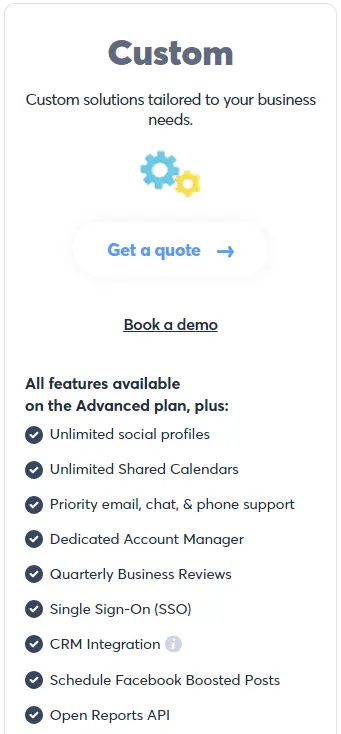
Source: agorapulse.com

Source: agorapulse.com
What You Get for the Cost
Data is a crucial component of any successful social media marketing effort—and using social media monitoring tools can get you all the data you need for your own campaigns. The costs of using these tools outweigh other similar approaches to getting this data like focus groups or interviews, with the added benefit of scaling their use based on your current needs.
Here’s a breakdown of the costs associated with popular social media monitoring tools:
Agorapulse Keyhole Cyfe Talkwalker Monthly price range $69 to $149 $189 to $449 $19 to $150+ Undisclosed Free trial ✅ ✅ ✅ ✅ Free plan ✅ ❌ ❌ ❌ Custom pricing ✅ ✅ ❌ ✅
Social Media Advertising Costs
Ad spending on social media advertising alone is estimated to reach around $500 billion in 2024. Last year, companies saw an overall decrease in marketing spending. CMO Survey found that the marketing budget as a percentage of the company budget lowered by 12.3%, indicating a slowdown in digital marketing spending.
The costs of advertising on social media platforms can sometimes be difficult to quantify given that the landscape of social media is often shifting, and some social media activities like rebranding can also drastically affect advertising costs.
However, there are certain benchmarks that brands can aim for when trying to allocate their advertising budgets. While these benchmarks are still heavily dependent on your marketing goals, they can still be excellent numbers to aim for if you’re just looking for a budget to quickly get started on your advertising campaigns.
While there are platforms that any brand should always maintain a presence in, the investment required in specific platforms will differ depending on their social media marketing strategy. You'll want to allot a certain amount of your social media marketing budget equally across all your social media platforms, but you'll also want to invest more into a specific platform depending on your goals.
Here is a closer look at the costs of advertising on each social media platform:
As one of the biggest social media platforms today, running advertisements on Facebook can generate high visibility. However, the larger audience on the platform does mean that Facebook advertising costs can be higher compared to other platforms, at least for initial campaign launches.
- $0.30 to $0.50 per click
- $1 to $3 per 1,000 impressions
- $0.10 to $2.50 per like
Depending on the size of your organization and how actively you want to push your advertising during your campaign, you could reasonably expect to spend around $100 to $500 per month on a single social media marketing campaign. In fact, more than 60% of businesses allocate $1 to $500 of their monthly budget to Facebook ads.
Of course, there are also companies that allocate much higher than this range. Brain & Body Health Center, for instance, spent $300,000 for a Facebook ad campaign that ran for a year. Led by PPC agency Yatter, Brain & Body Health Center was able to increase its leads, boost its revenue, and gain millions of ad impressions from the campaign.
However, not having a high-budget campaign doesn’t necessarily mean you can’t drive results. With the right strategies and research, a low budget can still help you achieve the goals you want from an ad campaign. Take for example Einsteinz Music. They spent just a little over $200 in 5 days and got the results they wanted. They ended up getting an ROI of $1,000 from the $240 they spent on ads.

Source: greenarrowdigital.com
Instagram’s large user base and emphasis on visual content make it one of the most effective platforms for advertising. A particular advantage for online marketplaces is Meta’s own support for linking shops directly to Instagram profiles and posts, making them well-suited for product placement.
- $0.10 to $0.50 per click
- $0.25 to $5 per 1,000 impressions
- $0.05 to $0.10 per engagement
Instagram’s advertising costs tend to vary wildly depending on your industry, though their pricing model and rates are similar to Facebook’s. However, keep in mind that the costs above are what you’d expect from direct advertising alone—it doesn't include other potential sources of promotion like influencer marketing. On average, you can expect to spend around $50 to $500 a month for your campaigns. Most businesses allocate 0% to 20% of their total advertising budget to Instagram ad costs.
The Resolve, an independent journalism entity, wanted to grow its followers just in time for its launch. It didn’t have much engagement on its Instagram account, which is why it sought the assistance of media company Indiegraf. With an Instagram ad budget of $374.80, it managed to increase its followers by 1,013 after just two weeks. From 371 followers, it grew its follower base to more than 2,200.
X (formerly Twitter)
While X has somewhat decreased in users over the past few years, it still remains one of the most popular social media platforms for marketing. It’s particularly effective if your brand wants to maintain and grow an active social following online, as it’s suitable for holding discussions and checking audience impressions almost in real-time.
- $0.50 to $2 per first action for promoted posts
- $1.25 to $2 per follow for promoted accounts
Since advertising on X works depending on your billable actions, it can allow for more flexible marketing costs compared to other social media platforms. However, the auction system itself encourages higher engagement pre-campaigns to get the most ROI — a setup that not all brands can manage. Because of this, costs for X advertisements hover around $150 to $1,000 per month. Most businesses allocate from 11% to 20% of their total budget to Twitter ads.
Innovet Pet Products, a supplier of CBD oil for dogs, spent around $2,000 on Twitter ads for a 30-day campaign. It credited Twitter for increasing its sales.
Rescued in Romania by Sadies Dog Rescue ?❤️ pic.twitter.com/S35N1sVnoM
— Innovet Pet Products (@innovetpet_) January 10, 2024
TikTok
TikTok’s popularity and high potential for engagement make it an excellent platform for social media marketing. However, the overall trend for advertising leans toward collaborations such as influencer marketing. It’s still possible to run advertising campaigns on the platform, though you’ll need to keep in mind that influencers will usually be the better choice.
- $0.20 to $2 per click
- $10 to $15 per 1,000 impressions
Brands wishing to use TikTok should note that given the overall competition on the platform, the initial costs of running a campaign can quickly grow over time. Successful campaigns can somewhat stabilize costs long-term, but this requires investment in other marketing strategies and approaches on the platform, which can be calculated differently from the costs above. Most campaigns cost around $500 (minimum budget) on TikTok and can be higher depending on the audience you’re targeting.
Hootsuite did a TikTok ad experiment and spent $345 on Spark Ads. The result? For both ad campaigns, it gained thousands of impressions, earned thousands of video views, and increased followers.

Source: blog.hootsuite.com
YouTube
YouTube is another platform that uses the bidding system to weigh advertising applications, which can make costs swing wildly from low to high depending on your industry. There are also other costs that can’t be calculated based on the advertising rates alone, like the costs of content production.
- $0.30 to $0.50 per click
- $0.10 to $0.30 per view
Because of the different ad formats available on YouTube, it’s possible that you’ll end up allocating more than your initial budget for a long-term campaign. Despite these sudden increases in costs, YouTube remains as a platform with high ROI for marketers, making it well worth the price. Running a campaign on YouTube typically costs around $700 to $1,000 per month.
Creatopy, an ad creation platform, tested whether YouTube video ads or audio ads can give advertisers better engagement. They spent $6,797 for the ad campaigns. The result? They found that audio ads brought in more impressions and users, but the video ads led to more clicks and a higher CTR.
How Do I Evaluate if the ROI of My Advertising Is Successful?
There are a variety of advertising pricing models that can affect the overall ROI of your marketing campaign. However, there are two metrics that you can use to help you calculate your ROI before you run a single advertisement:
- Cost per lead (CPL), which measures the actions taken by your audience after viewing your ad
- Cost per click (CPC), which measures how many times your ad is clicked by your audience
Each approach has its own advantages and disadvantages in terms of ROI, but a good rule of thumb to follow is to align your pricing model with your goals. If your aim is engagement, CPL is a more efficient way to calculate your ROI. Campaigns focused on building awareness will typically benefit better from a CPC approach, as the performance of these campaigns are easier to quantify and track.
The simplest answer is that the more visibility you get for your brand, the higher the ROI of your ad campaigns. But by measuring your advertising spend and overall costs of your campaign against a pricing model like CPL or CPC, you’ll be able to fine-tune how your advertising strategy plays out in the long term, which can lead to significant cost savings.
Social Media Team Costs
Social media teams aren’t always a given for social media marketing—depending on the size of your organization, you may not even have the resources for one—but they’re still an important factor to consider when calculating costs. While reputable tools can help automate social media marketing tasks, you’ll still need someone to oversee these processes and ensure that they work toward your marketing goals.
For social media personnel, brands have three options to consider:
- Social media marketing agencies
- Social media marketing freelancers
- Keeping social media in-house
In general, hiring a freelancer will cost less than hiring an agency. But depending on the needs of your marketing campaign, the benefits of choosing either a freelancer or an agency can outweigh the upfront costs.
Fortunately, both freelancers and agencies usually offer flexible prices—according to whether you charge them by the hour, monthly, or on retainer. This flexibility can lower or increase the costs depending on your negotiations with your provider.
Freelancer Costs
Some freelancers specialize in a specific area of social media marketing, which can be appealing if you only need support on certain tasks. Since you’re only paying for their specialization, the upfront costs of hiring a freelancer are less expensive compared to agencies. On average, you can expect freelancers to cost around the following:
- $15 to $30 per hour
- $700 to $1,500 per month
- $10,000 and above as a retainer
The costs of freelancers can typically be negotiated depending on how you connect with them. However, keep in mind that the different ways you can connect and hire freelancers can also add to their costs.
For example, hiring freelancers through portals like Upwork are typically cheaper, but the fees demanded by the Upwork platform can add up over time. This incentivizes brands to do their own outreach to recruit a freelancer for their social media marketing.
Social Media Marketing Agency Costs
The biggest draw of hiring an agency is having an entire team with all the necessary skills, specialties, and expertise to push your social media marketing. On average, agencies will cost around the following:
- $60 to $180 per hour
- $500 to $5,000+ per month
- $15,000 and above as a retainer
The cost of social media marketing agencies is priced according to the support that they’ll provide for your campaign. However, you can also negotiate with them depending on your needs. Just keep in mind that the more comprehensive services offered by an agency means there’s less room to adjust their pricing. Some agencies also offer social media marketing packages, which would include a set of specified services at a fixed price.
What Are the Costs of Keeping Everything In-House?
Freelancers and social media agencies are the preferred option for many brands, but there’s nothing stopping you from cultivating and training your own talent. In theory, the costs associated with training and retaining social media teams in-house will even out in the long term. However, the upfront cost is typically the biggest barrier preventing brands from doing this as default.
But if your brand has the time, resources, and personnel to build a social media team of your own, the benefits can outweigh the costs. Some brands and organizations choose to support their in-house teams with the services of an agency or a freelancer when necessary, typically for large-scale projects like product launches.
Overall, keeping your social media team in-house is the ideal balance between costs and results, though it does require time and effort to be a successful approach for your brand’s social media marketing.
Wrapping Up
The true cost of social media marketing platforms is always shifting. New trends and technologies like artificial intelligence can have a significant impact on how much your marketing efforts will cost.
Getting a good grasp on the core components of your social media marketing is a good starting point for accounting for all other costs. With time and experience, brands can weather costs when they understand the factors that contribute to a brand’s success on social media.
Frequently Asked Questions
What are the average costs of marketing on different social media platforms?
According to digital marketing solutions provider WebFX, the average cost of marketing on different social media platforms is as follows:
- Facebook advertising: $0 – $5 per action
- Instagram advertising: $0 – $4
- X (formerly Twitter) advertising: $0.26 – $2.00
- YouTube advertising: $0.31 – $0.40 per view
- Pinterest advertising: $0 – $2 per action
- LinkedIn advertising: $0.26 – $8 per action
Keep these figures in mind when calculating the overall costs of your social media marketing campaigns, but only after you’ve already allotted budgets for the core components discussed earlier.
How many social media platforms should brands use for marketing?
While it may seem like a good idea to expand your brand’s online presence across as many different platforms as possible, it’s far better to focus on specific platforms that work best with your brand. This doesn’t mean that expanding to multiple platforms shouldn’t be done—it may be the best move to rapidly grow your reach—but it shouldn’t be something included in your marketing plan unless necessary.
Should social media marketing be handled in-house or outsourced?
Outsourcing marketing to an agency, platform, or third party can certainly help you save on costs, but only under specific circumstances. Outsourcing social media marketing vs. keeping the work in-house will depend on many factors, including but not limited to:
- The overall size of your marketing budget
- The goal of your social media campaign
- The expertise you have in social media marketing
- The concerns you have about data privacy and security
- The non-financial resources you can use for social media marketing
A good rule of thumb to follow is that outsourcing social media marketing is cost-efficient if you have a need that your internal team can neither fulfill nor have the time to learn like content creation. For reference, Statista found that nearly half of Asia-Pacific companies outsource some parts of their social media activities in 2023.
Should I hire a social media marketing agency or a freelancer?
Costs are one of the most important factors to consider in hiring a social media marketing agency or a freelancer. Overall, the bigger your organization or brand, the more beneficial a social media marketing agency will be.
While a freelancer can certainly help you manage your social media marketing, there’s a limitation to what a single individual can do in terms of marketing support. Freelancers are suitable for smaller, low-production, and highly targeted campaigns; they can bring a higher ROI for relatively smaller budgets.
Bigger brands and campaigns benefit from hiring an agency over a freelancer since more manpower and resources translate to more versatility and better results. A highly visible campaign will require more production value in terms of content creation, community management, and analytics/research. Social media marketing agencies are better equipped to meet these varied needs compared to freelancers.

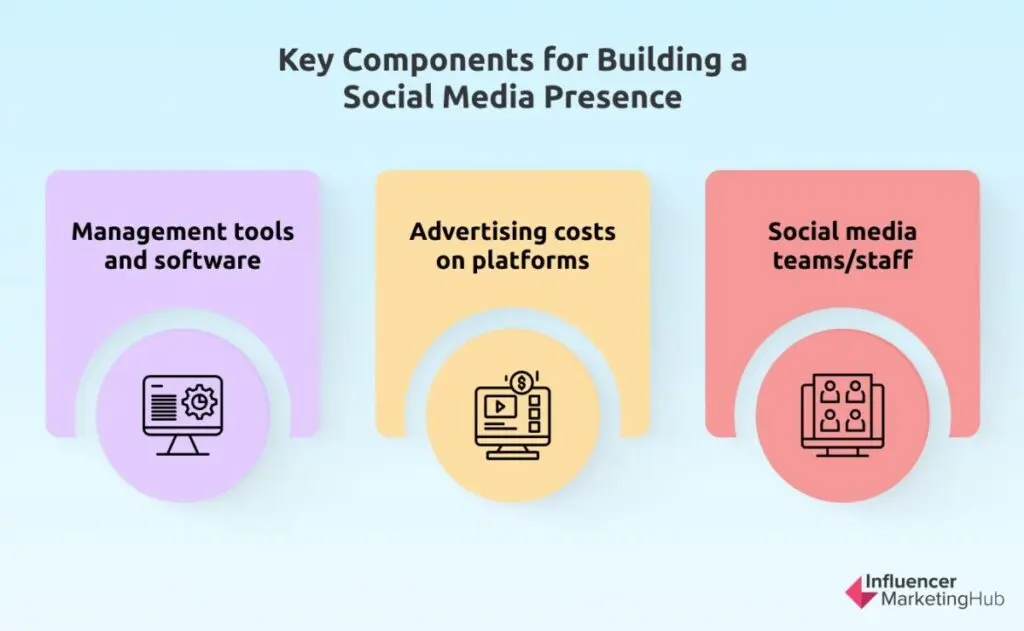
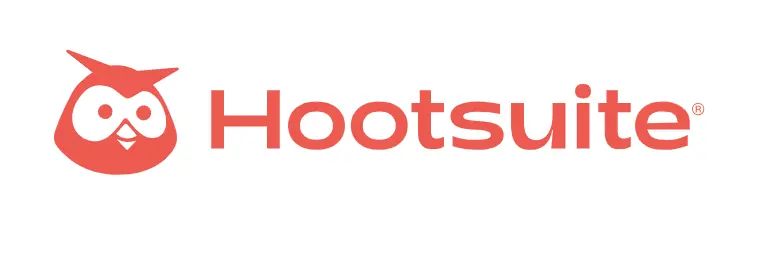
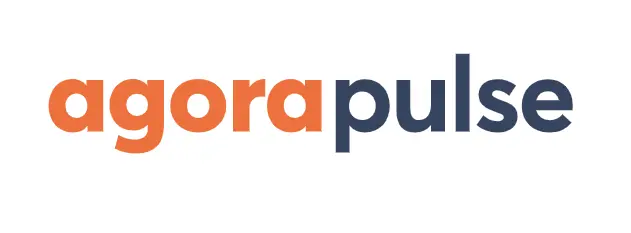




![What is a Social Media Marketing Platform [The Ultimate Guide]](https://s.influencermarketinghub.com/imaginary/resize?width=400&height=200&type=webp&url=https://influencermarketinghub.com/wp-content/uploads/2024/07/361.png)